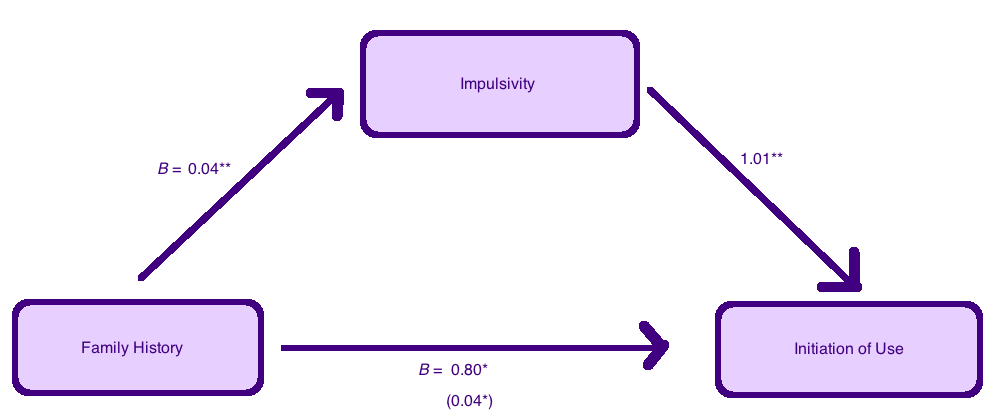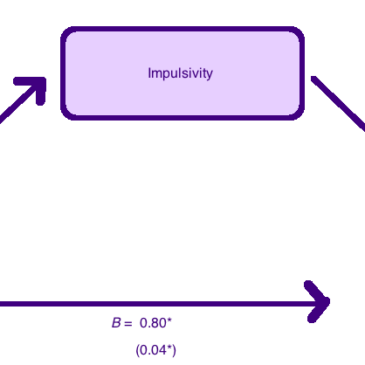People try drugs for a variety of reasons. Family history of use often is a significant predictor of substance use, and experimentation frequently starts during adolescence. Previous research shows that there are certain traits, such as novelty-seeking, that manifest within families along with substance use behaviors (Young et al., 2000). Consequently, it is possible that novelty seeking accounts for some of the transmission of substance use from parents to children. Further, people who are high or low in novelty seeking might respond differently to using the same drugs—so that novelty seeking itself might influence future use. This week’s STASH reviews a study by Bidwell and colleagues (2015) that examined how novelty-seeking among adolescents relates to licit and illicit drug use, family history of substance use, and subjective drug effects.
Methods
- The study surveyed 585 adolescent participants (50.8% male; 72% response rate), all of whom were 9th graders in Los Angeles who agreed to participate and provided parental consent.
- Researchers administered a battery of self-report assessments including the following:
- The substance use measures from the Youth Risk Behavior Surveillance Survey (Eaton et al., 2010) and the Monitoring the Future questionnaire (Johnston et al., 2010) to assess substance use initiation and frequency of any substance use in the past month;
- Two novelty-seeking subscales from the abbreviated Temperament and Character Inventory (Cloninger et al., 1994): impulsivity (e.g., “I often do things based on how I feel at the moment”) and exploratory excitability (e.g., “I often try new things just for fun and thrills”).
- The occurance of family history of substance abuse among immediate family members, on a scale from 0-3. Higher scores indicated more extensive family history of substance abuse (i.e., smoking, alcohol abuse problems, and other substance abuse problems),
- A measure of how positive and negative subjective effects of a variety of substances (modified Lyons Battery for Subjective Effects; Lyons et al., 1997). A typical question was, “Over the past 6 months, in the period shortly after you [used substance] did it make you feel [drowsy, euphoric etc.]?”
- The researchers completed regressions to examine how family history, novelty-seeking subscales, and subjective responses to substances combined to predict (1) initiating substance use (of any kind) and (2) frequency of substance use.
Results
- Teens who reported more extensive family histories of substance use problems reported more impulsivity (β=0.04). In addition, teens who scored higher on impulsivity were at higher risk of having initiated substance use (β = 1.01). These relationships were statistically significant.
- Participants’ impulsivity mediated the relationship between family history of substance abuse and participants’ own initiation of substance use (indirect path β = 0.04; 95% CI[ES2]: 0.01–0.09).1 See Figure 1 below for visual representation.
- The authors observed the same pattern for frequency of past 30-day substance use.
- In contrast, exploratory excitability did not mediate the relationship between family history of substance use and initiation of use or frequency of past 30-day use.

Figure. Mediation model demonstrating the effect of impulsivity on the relationship between family history of substance use and initiation of substance use. Beta in parenthesis shows relationship between family history and initiation with impulsivity included in the model (indirect effect). * denotes p < 0.05, ** denotes p < 0.01. Adapted from Bidwell et al. (2015). Click image to enlarge.
- Next the researchers looked at the effect of positive subjective effects of substance use on the relationship between impulsivity and past 30-day use.
- Teens who scored high on impulsivity were more likely to report positive effects of substance use (β = 2.11) and also reported using substances more frequently in the past 30 days (β = 0.44).
- In turn, the participants who were more likely to experience positive effects of drugs reported more frequent past-month (β = 0.44)
- Feeling “good” or better after using drugs appeared to mediate the relationship between impulsivity and frequent substance use (β = 0.06; 95%CI : 0.01-0.12). See Figure 2 below for visual representation.

Figure. Mediation model demonstrating the effect of subjective effects on the relationship between impulsivity and past 30 days use. Beta in parenthesis shows relationship between impulsivity and past 30-day use with positive subjective effects included in the model (indirect effect). * denotes p < 0.05, ** denotes p < 0.01, *** denotes p < 0.001, **** p < 0.0001. Adapted from Bidwell et al. (2015). Click image to enlarge.
Limitations
- The study used a convenience sample from 2 public high schools in Los Angeles, so generalizability may be limited.
- The cross-sectional design prevents discussion of causal relationships among the variables in question: novelty seeking, family history, subjective effects, and substance use.
- The study depends upon retrospective reports of acute drug effects, which are not always reliable or accurate.
- The researchers did not collect data on drug dosage, which could affect subjective effects of use and continued substance use.
- Similarly, the family subscale did not ask about level/frequency of family members’ use, so we are unable to comment upon how intensity of use might alter the relationship between family history and adolescent substance use patterns.
Conclusions
The results of this study demonstrate that impulsivity may be the component of novelty seeking that affects “substance use proneness” among adolescents – particularly those with a family history of substance use. Impulsive teens could be more sensitive to the effects of drugs, particularly positive effects, which might reinforce their use (and escalation of use). If future (larger scale/longitudinal) studies can replicate and support these results, they could inform the development of more targeted strategies to help at-risk youth based on their personality or family profiles.
–Emily Shoov
What do you think? Please use the comment link below to provide feedback on this article.
References
Bidwell, L. C., Knopik, V. S., Audrain-McGovern, J., Glynn, T. R., Spillane, N. S., Ray, L. A., Riggs, N. R., Guillot, C.R., Pang, R.D., & Leventhal, A. M. (2015). Novelty Seeking as a Phenotypic Marker of Adolescent Substance Use. Substance Abuse: Research and Treatment, 9(Suppl 1), 1–10.
Cloninger, C.R., Przybeck, T.R., Svrakic, D.M., & Wetzel, R.D. (1994). The Temperament and Character Inventory (TCI): A Guide to its Development and Use. Center for Psychobiology and Personality
Eaton, D.K., Kann, L., Kinchen, S., Shanklin, S., Ross, J., Hawkins, J., Harris, W.A., Lowry, R., McManus, T., Chyen, D., Lim, C., Whittle, L., Brener, N.D., & Wechsler, H., Centers for Disease Control and Prevention (CDC). (2010) Youth risk behavior surveillance: MMWR Surveill Summ. 59(5):1–142.
Johnston, L.D., O’Malley, P.M., Bachman, J.G., & Schulenberg, J.E. (2010) Monitoring the Future National Survey Results on Drug Use, 1975−2009. Volume I: Secondary School Students. National Institute on Drug Abuse
Lyons, M.J., Toomey, R., Meyer, J.M., Green, A.I., Eisenm S,A, Goldberg, J., True, W.R., & Tsuang, M.T. (1997) How do genes influence marijuana use? The role of subjective effects. Addiction. 92(4):409–417.
Young, S.E., Stallings, M.C., Corley, R.P., Krauter, K.S., & Hewitt, J.K. (2000) Genetic and environmental influences on behavioral disinhibition. American Journal of Medical Genetics. 96(5):684–695.
________________
[1] This held true after controlling for exploratory excitability and demographic characteristics.





Andrewbrown365 November 5, 2015
I’ve been interested in whether a focus on personality types might be a better (or at least alternative) way of targeting prevention resources than the traditional risk and protective factors since coming across Patricia Conrod’s work in the UK from a few years ago.
I think it’s worth looking a what she’s found in the various RCTs that she and colleagues have done around the Preventure/Adventure intervention and the use of the Substance Use Risk Profile Scale to try to identify people at higher risk of developing substance misuse problems.